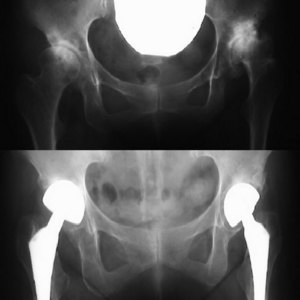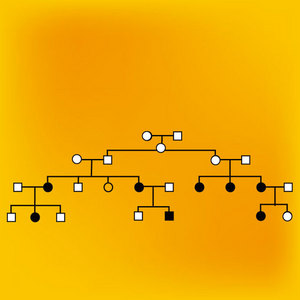Aug. 11, 2006 Research Highlight Biology Medicine / Disease
Novel genetic link found for familial degenerative hip arthritis
Genetic detectives link a type of devastating hip arthritis to novel chromosome location
 Figure 1: An X-ray (autoradiograph) of diseased hips (top) that were replaced by surgery with artificial, metal joints (bottom).
Figure 1: An X-ray (autoradiograph) of diseased hips (top) that were replaced by surgery with artificial, metal joints (bottom).
Moving freely by walking is a remarkable ability almost all of us enjoy. But disease can claim victim the ability to walk, especially as we age. Degenerative arthritis of the hip joint (hip OA), for example, can cause extreme pain, inactivity and complete crippling. The causes of hip OA vary, but some types of the disease are found clustered in families, which strongly indicates a genetic cause.
In The American Journal of Human Genetics 1, Shiro Ikegawa and colleagues at RIKEN’s SNP Research Center, in Yokohama, describe evidence from a large Japanese family for a genetic cause of a new type of familial hip OA. The new information may help unravel the cause of this and other types of hip OA—a collection of diseases that affects thousands of people, especially of French and Japanese descent.
The new study is akin to a detective story and the search for the cause of an elusive menace. The menace is hip OA. The investigators are detectives seeking medical information that might provide a clue about a genetic link to hip OA. One difficulty is that not all types of hip arthritis are the same. Many types of hip inflammation occur; there are even different types of hip arthritis.
 Figure 2: The graph indicates the family tree of the disease, with affected individuals in black and unaffected siblings and relatives in white. Males are represented by squares and females by circles.
Figure 2: The graph indicates the family tree of the disease, with affected individuals in black and unaffected siblings and relatives in white. Males are represented by squares and females by circles.
But some forms of hip OA have a clear genetic component, which is determined by the frequency of hip OA in immediate family members and the ‘dominant’ appearance—like hair color—of the disease. Ikegawa and colleagues found such evidence in one patient and her family (Fig. 1). “An elderly Japanese woman had been seeing a doctor, one of the co-authors,” says Ikegawa. “One day she was asked about her family. It was a start.”
A detailed family history revealed a genetic link to crippling hip OA, usually beginning in adolescence and worsening over time, often requiring surgical hip-joint replacement. Painstakingly, Ikegawa and colleagues spent two years working to find that the affected members of the Japanese family almost certainly have a single mutation on chromosome 13 that is responsible for the disease.
“This is the starting point for identifying a [new] hip OA gene, which could lead to innovative treatment,” says Ikegawa. Although hip OA is not yet cured, the cause of this devastating disease may now be closer at hand through the work of science detectives like Ikegawa and his group.
References
- 1. Mabuchi, A., Nakamura, S., Takatori, Y. & Ikegawa, S. Familial osteoarthritis of the hip joint associated with acetabular dysplasia maps to chromosome 13q. The American Journal of Human Genetics 79, 163–168 (2006). doi: 10.1086/505088
